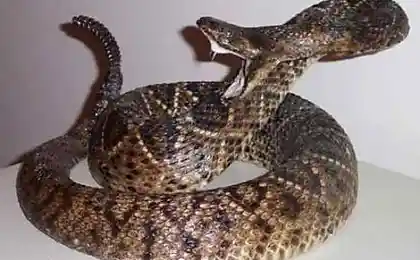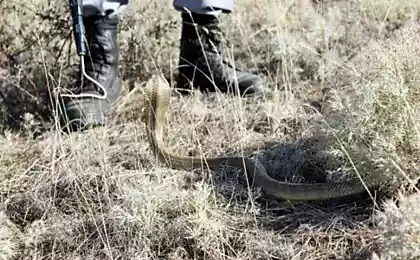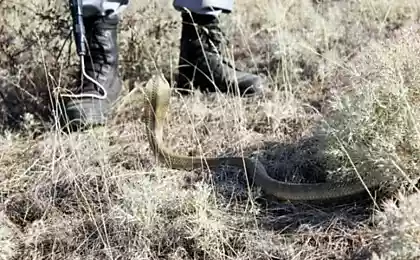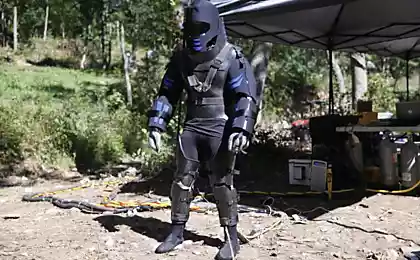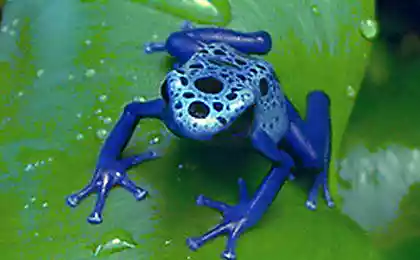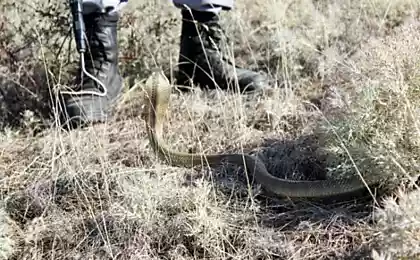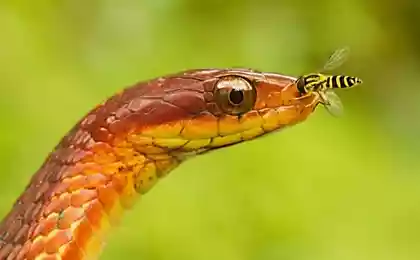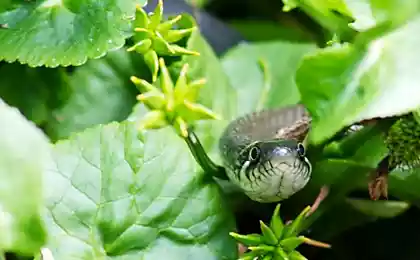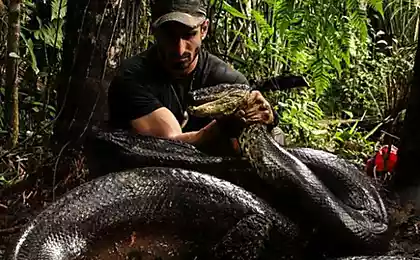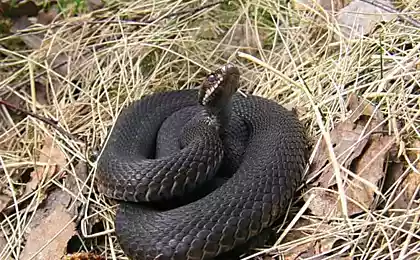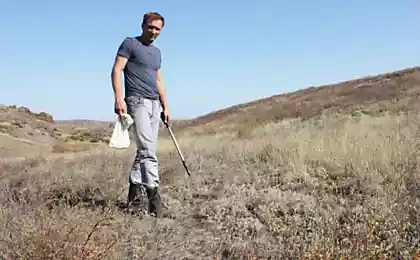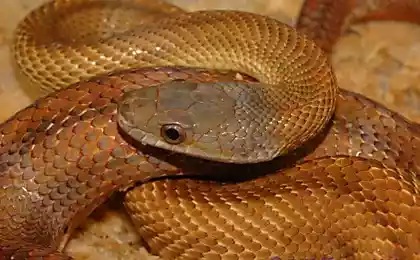3099
Snakes region (4 photos)
I ask a question here that for a snake in our lovely Moscow region are found. I am not a child in the time child snakes caught, but the other no longer met. Snakes on the planet about 2,500 species, of which about 400 are poisonous. We have as I understood the most dangerous and the only venomous viper it (it is in the photo below). Compiled materialchik, who may be interested to read.
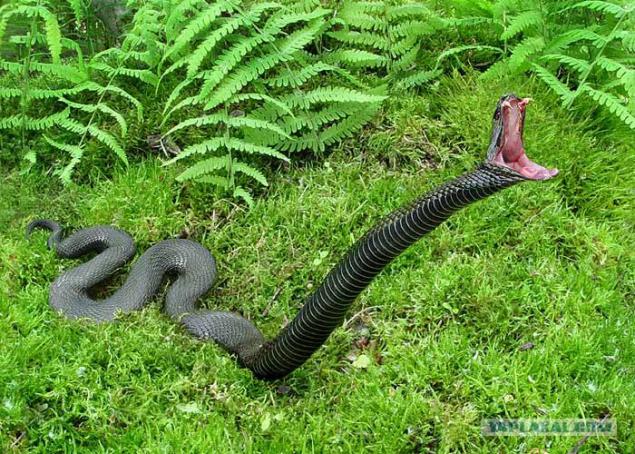
Already
Adders are distinguished from other snakes' yellow ears "- highly visible markings on the head, usually yellow, sometimes white and orange. Females are larger males sometimes reach up to 1, 5 meters, but most often no larger than a meter. It feeds mainly on live frogs, rodents and fish less often. The enemies are snakes storks, birds of prey and some mammals.
Oh well tamed and brings bondage. Ukraine and Belarus are frequent instances of domestication snakes (for the destruction of mice).
Oh, not aggressive. At the sight of a man, he flees. Caught at first too actively protected: hisses and throws his head forward, which operates in many intimidating enemies. If this does not work, he spews recently eaten food, pretending to be dead. Bites often. For a man bite almost a no-brainer.
Adders great swim under water may be more than an hour, and at Pheasant too may be under water many times more - he had a length of only 15 cm, and the hole is rarely allowed.
In April - May the mating season begins. In July - August, females looking for snakes, which lay their eggs: in damp and warm places. Ideally suited for this pile of humus, old straw, fallen leaves, also suitable raw moss, rotten stumps and mouse holes. In October - November crawl at various holes and crevices in the ground, where they spend the winter. Already pheasant hibernates in his fist.
Already common is widespread in Europe, except for the polar regions, in southern Siberia to Lake Baikal in the south of the Far East.
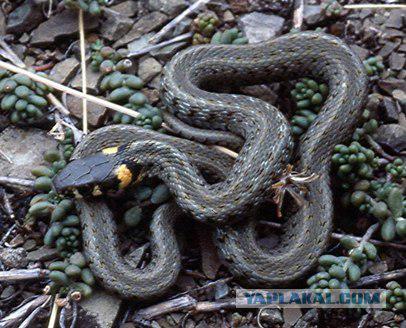
Copperhead
Coronella (lat. Coronella) - a small genus of the family colubridae comprising only 3 species found in Europe, North - West Africa (Morocco, Algeria and Tunisia) and South Asia (India), although recently he was treated three other African species. On the territory of Russia is found only one species - common copperhead (lat. Coronella austriaca).
The body length is 70 cm, the tail in 4 - 6 times shorter than body. The smooth dorsal scales are rhomboid or hexagonal shape. On the ventral shields visible keels forming ribs on the edges of the belly. Anal plate is divided into two, rarely - three. Rostral plate strongly wedged between mezhnosovymi. Around the middle of the body - 19 scales along the belly - Flap 150-182 170-200 in males and females, undernail - 40 - 70 pairs. The first vertical row of her are two (sometimes one) parietal shield, the second - 2 - 3. Nostril between two nasal shields Preorbital one (sometimes two), there is no infraorbital (sometimes replaces the small plate, which lies between the second and third supralabial shields or over a third), postorbital guards - two.
From other European copperhead snakes is well characterized by the presence of dark stripe through the eye, and transverse bands or spots on the body. Painting her back varies from gray to yellow-brown and brown-copper-red, with the males dominate the reddish-brown tones, and the females - brownish. On the upper side of the body is located 2 - 4 rows of transversely elongated spots sometimes merge into strips (which may be expressed very weakly and almost invisible). On the nape of her are combined with each other, two brown spots or stripes. Belly - from gray or bluish steel to brownish red color, with dark spots and blurred or mottled dark gray stripe down the middle. Iris of the eye of the snake is usually red. From the nostrils through the eye and the corner of his mouth to his neck stretches a dark stripe.
It lives in almost all of Europe (except Ireland, the majority of the UK, northern Scandinavia, central and southern parts of the Iberian Peninsula and the islands of the Mediterranean Sea) to the west of Kazakhstan and the Caucasus, as well as to the north of Iran. The main part of the range takes a nominative subspecies whose range in northern Russia reached within Tula and Ryazan regions. Individual findings are known from the Moscow region. On the southern island of Sicily and the Pyrenees subspecies C. a. fitzingeri (Bonaparte, 1840), which differs from the nominative smaller size and the presence of a few dorsal spots.
Coronella prefer forested clearing, sunny edge of the dry grassland and deforestation in various types of forests, avoiding the rough places, even good swimmers. The mountains rise to a height of 3000 m above sea level, rocky steppe obzhivaya areas with xerophytic vegetation. They serve as shelters burrows of rodents and lizards, void under rocks and fallen tree trunks bark, cracked rocks.
Leads this snake daily life, but sometimes it comes out of hiding in the evening and even on clear moonlit nights. For several years, it does not change their individual plots.
Active season lasts about 0.5 years. Coronella leave for the winter in September - October. And for 1 - 1.5 months before they appear from 2 to 15 pups length 12.5 - 17.5 cm. This is a result of the spring copulation (in May), but the pairing may occur in the fall. In this case, the female gives birth to calves next spring (sperm remain until spring, are stored in the seminal receptacle of the female). In the search for a partner plays a special role allocation cloacal glands. During copulation the male holds the female in the neck jaws, wrapping her body around her own. The eggs remain in the female body almost to the full development of the embryos (ovoviviparity). Cubs appear in thin egg shells that burst shortly after birth, and juveniles immediately begin an independent life. Sexual maturity occurs in the third year of life.
They feed mainly Coronella (almost 60%), lizards (optional zaurofagiya), in particular - anguis and the sand lizard, less frequently (5% incidence) - other small vertebrates (mice, voles, shrews and chicks passerine bird, frog). The rest of the volume of production accounted for insects that are probably secondary food (getting into the stomach from the digestive tract swallowed lizards). Swag Coronella compressed rings of the body (like a boa constrictor), eating her alive. Sometimes use poisonous teeth arranged in the interior cavity, through which paralyze large food items. They noted, and cannibalism.
On copperhead can attack martens, hedgehogs, wild boars, rats and some birds. The young lady even eat grass frog. Copperhead is protected from enemies, shrinking into a tight ball, which she hides her head and hissed, makes shots in the direction of danger. Coronella toxic saliva. From the enemy are still allocation okolokloakalnyh glands with an unpleasant odor.
This type of snake is included in the Red Book of Belarus and Moscow region

Viper
Adder (lat. Vipera berus) - view of this kind of poisonous snakes viper vipers of the family are common in Europe and Asia. Unlike other members of the family prefers cooler temperatures, either occurring at higher latitudes (up to the Arctic Circle), or high in the mountains (reaching 3,000 meters in the Swiss Alps)
Adder, as a rule, the average size - males reach 60cm, females 70cm. In the north area are rare specimens reach 1 meter in length. The head is separated from the body a short neck, face the top, in front of the line connecting the front edge of the eye, it has a large 3 panel (one in the middle and two on each side), and a number of smaller ones. The muzzle is rounded at the end. Bow hole is cut in the middle of the nose guard. Coloration varies from gray and bluish to coppery red and black, with a distinctive zig-zag pattern on the back along the spine. The latter figure is almost indistinguishable.
Lives adder an average of 11-12 years. Quickly adapts to any terrain and can live at altitudes up to 3,000 meters above sea level. The spread unevenly depending on the availability of suitable wintering places. Settlement, usually it does not move further 50-100 meters. An exception is the forced migration to wintering areas, snakes in this case can retire to a distance of 5 km. Hibernation usually occurs in October-November and March-April (depending on climate), which selects a depression in the ground (holes, crevices, and so on. D.) To a depth of 2 meters, where the temperature does not drop below 2 - 4 ° C. In the case of shortage of places in one place may accumulate several hundred individuals that spring creep to the surface, giving the impression of large overcrowded. Subsequently, snakes crawl. In the summer, often it is basking in the sun, in the rest of the time hiding under the old stumps, in crevices, and so on. N. Nonaggressive snake, and at the approach of a man trying to use their camouflage color as much as possible, or to retire. Only in case of sudden appearance of a person or in the case of provocation on his part, she may try to bite him. Such cautious behavior due to the fact that it requires a lot of energy for reproduction of the poison in the face of changing temperatures. It feeds mainly on rodents, amphibians and lizards, but sometimes eats birds and their eggs.
Mating season is in May, and the offspring appears in August or September, depending on the climate. Viper viviparous - eggs develop and hatch cubs in the womb. Usually it appears to 8-12 young individuals, depending on the length of the female. It happens that at the time of childbirth female chokes the tree or stump, leaving a tail canopy, "throwing" the earth kids who from the first moments of starting their own life. Juveniles usually 15-20 cm in length and have poisonous. Many believe that only individuals born more toxic, but this is not true. It is also true that young individuals are more aggressive. Just born, snakes usually shed. Subsequently moulting occurs young adult 1 - 2 times a month. Before his first hibernation in October and November, they never eat, because before the state of hibernation should digest all the food eaten to avoid problems with metabolism.
Adder deadly poisonous, and its venom is similar to the venom of rattlesnakes. However, it produces a much smaller amount of poison than the latest, and for that reason is considered to be less dangerous. The bite is rarely fatal. However, the bitten person should seek immediate medical attention. The structure consists of high-venom protease hemorrhagic, necrotizing gemokoaguliruyuschego and neurotropic action and low molecular weight cytotoxins. As a result of the bite there hemorrhagic edema, necrosis and hemorrhagic impregnation of tissue in the area of administration of poison, accompanied by dizziness, weakness, headache, nausea, shortness of breath. To further develop progressive shock of complex origin, acute anemia, intravascular coagulation, increased capillary permeability. In severe cases occur degenerative changes in the liver and kidneys. In the spring of viper venom is more toxic than the summer.
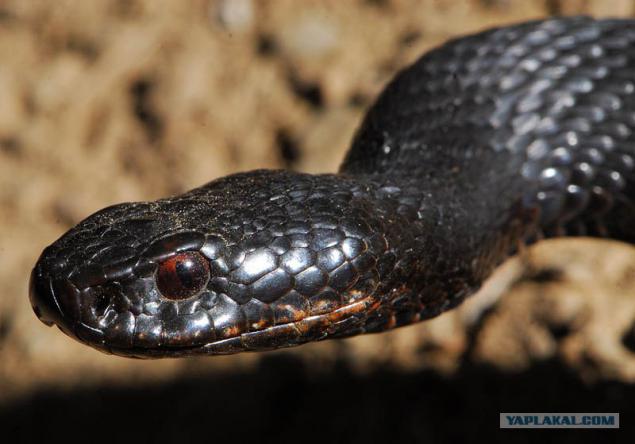
Comment specialist
What to do if you have a viper snatched ...
Physician-toxicologist Paul TKACHUK:
- At the site of the bite after a few minutes there is swelling, which together with the bruise soon spread to the entire limb and the adjacent part of the body. There are severe pain, a burning sensation, severe nausea, vomiting, muscle weakness, drowsiness, cold sweats, fever. Fastest poisoning develops when the bite is made into a major blood vessel. But no need to panic.
Fix the limb (ie, do not try to move it) to suspend the distribution of blood flow and blood poison.
If the hand is antihistamines (tavegil, suprastin), you can take 1 tablet, but consider them sleepy.
You also need to drink as much as possible.
And most importantly, do not expect that everything will be held even if the acute pain let go, an urgent need to see a doctor. At the hospital, the victim will enter protivozmeinuyu serum and hold detoxification. If you do not take action, death can occur both within an hour of the bite, and after 10 - 14 days.
... Or your dog
Viper Sting (and only this kind of dangerous snakes in our band) for the dog is not lethal. But carrying heavy, particularly bites to the head and neck.
If you are in the country, it is useful to stock up antigadyuchnoy serum (ampoules in the "human" the pharmacy is 195 rubles., Store in the refrigerator).
The serum is administered as soon as possible after the bite subcutaneously, well before this to make the dog an injection or dimedrol pipolfen.
If serum is not at hand, good old-fashioned method. If you are going on a long hike, grab a large onion, a flask of vodka, a syringe and two ampoules - diphenhydramine (antihistamine) and kordiamina (support for the heart). When a snake bite you must act quickly enough.
Cut onion in half, puts one half of a cut to the site of the bite, and keep up until the onion turns blue. The same with the second half. Then pour in the pet's mouth 1 - 2 tablespoons vodka, tunic dimedrol vial and then kordiamina. Everything, now get to the house where plenty otpaivat psinka milk.
Approximately three days pet will lay formation, do not touch it - the medicine is excessive drinking and sleeping.
VIA
VIA
Source:

Already
Adders are distinguished from other snakes' yellow ears "- highly visible markings on the head, usually yellow, sometimes white and orange. Females are larger males sometimes reach up to 1, 5 meters, but most often no larger than a meter. It feeds mainly on live frogs, rodents and fish less often. The enemies are snakes storks, birds of prey and some mammals.
Oh well tamed and brings bondage. Ukraine and Belarus are frequent instances of domestication snakes (for the destruction of mice).
Oh, not aggressive. At the sight of a man, he flees. Caught at first too actively protected: hisses and throws his head forward, which operates in many intimidating enemies. If this does not work, he spews recently eaten food, pretending to be dead. Bites often. For a man bite almost a no-brainer.
Adders great swim under water may be more than an hour, and at Pheasant too may be under water many times more - he had a length of only 15 cm, and the hole is rarely allowed.
In April - May the mating season begins. In July - August, females looking for snakes, which lay their eggs: in damp and warm places. Ideally suited for this pile of humus, old straw, fallen leaves, also suitable raw moss, rotten stumps and mouse holes. In October - November crawl at various holes and crevices in the ground, where they spend the winter. Already pheasant hibernates in his fist.
Already common is widespread in Europe, except for the polar regions, in southern Siberia to Lake Baikal in the south of the Far East.

Copperhead
Coronella (lat. Coronella) - a small genus of the family colubridae comprising only 3 species found in Europe, North - West Africa (Morocco, Algeria and Tunisia) and South Asia (India), although recently he was treated three other African species. On the territory of Russia is found only one species - common copperhead (lat. Coronella austriaca).
The body length is 70 cm, the tail in 4 - 6 times shorter than body. The smooth dorsal scales are rhomboid or hexagonal shape. On the ventral shields visible keels forming ribs on the edges of the belly. Anal plate is divided into two, rarely - three. Rostral plate strongly wedged between mezhnosovymi. Around the middle of the body - 19 scales along the belly - Flap 150-182 170-200 in males and females, undernail - 40 - 70 pairs. The first vertical row of her are two (sometimes one) parietal shield, the second - 2 - 3. Nostril between two nasal shields Preorbital one (sometimes two), there is no infraorbital (sometimes replaces the small plate, which lies between the second and third supralabial shields or over a third), postorbital guards - two.
From other European copperhead snakes is well characterized by the presence of dark stripe through the eye, and transverse bands or spots on the body. Painting her back varies from gray to yellow-brown and brown-copper-red, with the males dominate the reddish-brown tones, and the females - brownish. On the upper side of the body is located 2 - 4 rows of transversely elongated spots sometimes merge into strips (which may be expressed very weakly and almost invisible). On the nape of her are combined with each other, two brown spots or stripes. Belly - from gray or bluish steel to brownish red color, with dark spots and blurred or mottled dark gray stripe down the middle. Iris of the eye of the snake is usually red. From the nostrils through the eye and the corner of his mouth to his neck stretches a dark stripe.
It lives in almost all of Europe (except Ireland, the majority of the UK, northern Scandinavia, central and southern parts of the Iberian Peninsula and the islands of the Mediterranean Sea) to the west of Kazakhstan and the Caucasus, as well as to the north of Iran. The main part of the range takes a nominative subspecies whose range in northern Russia reached within Tula and Ryazan regions. Individual findings are known from the Moscow region. On the southern island of Sicily and the Pyrenees subspecies C. a. fitzingeri (Bonaparte, 1840), which differs from the nominative smaller size and the presence of a few dorsal spots.
Coronella prefer forested clearing, sunny edge of the dry grassland and deforestation in various types of forests, avoiding the rough places, even good swimmers. The mountains rise to a height of 3000 m above sea level, rocky steppe obzhivaya areas with xerophytic vegetation. They serve as shelters burrows of rodents and lizards, void under rocks and fallen tree trunks bark, cracked rocks.
Leads this snake daily life, but sometimes it comes out of hiding in the evening and even on clear moonlit nights. For several years, it does not change their individual plots.
Active season lasts about 0.5 years. Coronella leave for the winter in September - October. And for 1 - 1.5 months before they appear from 2 to 15 pups length 12.5 - 17.5 cm. This is a result of the spring copulation (in May), but the pairing may occur in the fall. In this case, the female gives birth to calves next spring (sperm remain until spring, are stored in the seminal receptacle of the female). In the search for a partner plays a special role allocation cloacal glands. During copulation the male holds the female in the neck jaws, wrapping her body around her own. The eggs remain in the female body almost to the full development of the embryos (ovoviviparity). Cubs appear in thin egg shells that burst shortly after birth, and juveniles immediately begin an independent life. Sexual maturity occurs in the third year of life.
They feed mainly Coronella (almost 60%), lizards (optional zaurofagiya), in particular - anguis and the sand lizard, less frequently (5% incidence) - other small vertebrates (mice, voles, shrews and chicks passerine bird, frog). The rest of the volume of production accounted for insects that are probably secondary food (getting into the stomach from the digestive tract swallowed lizards). Swag Coronella compressed rings of the body (like a boa constrictor), eating her alive. Sometimes use poisonous teeth arranged in the interior cavity, through which paralyze large food items. They noted, and cannibalism.
On copperhead can attack martens, hedgehogs, wild boars, rats and some birds. The young lady even eat grass frog. Copperhead is protected from enemies, shrinking into a tight ball, which she hides her head and hissed, makes shots in the direction of danger. Coronella toxic saliva. From the enemy are still allocation okolokloakalnyh glands with an unpleasant odor.
This type of snake is included in the Red Book of Belarus and Moscow region

Viper
Adder (lat. Vipera berus) - view of this kind of poisonous snakes viper vipers of the family are common in Europe and Asia. Unlike other members of the family prefers cooler temperatures, either occurring at higher latitudes (up to the Arctic Circle), or high in the mountains (reaching 3,000 meters in the Swiss Alps)
Adder, as a rule, the average size - males reach 60cm, females 70cm. In the north area are rare specimens reach 1 meter in length. The head is separated from the body a short neck, face the top, in front of the line connecting the front edge of the eye, it has a large 3 panel (one in the middle and two on each side), and a number of smaller ones. The muzzle is rounded at the end. Bow hole is cut in the middle of the nose guard. Coloration varies from gray and bluish to coppery red and black, with a distinctive zig-zag pattern on the back along the spine. The latter figure is almost indistinguishable.
Lives adder an average of 11-12 years. Quickly adapts to any terrain and can live at altitudes up to 3,000 meters above sea level. The spread unevenly depending on the availability of suitable wintering places. Settlement, usually it does not move further 50-100 meters. An exception is the forced migration to wintering areas, snakes in this case can retire to a distance of 5 km. Hibernation usually occurs in October-November and March-April (depending on climate), which selects a depression in the ground (holes, crevices, and so on. D.) To a depth of 2 meters, where the temperature does not drop below 2 - 4 ° C. In the case of shortage of places in one place may accumulate several hundred individuals that spring creep to the surface, giving the impression of large overcrowded. Subsequently, snakes crawl. In the summer, often it is basking in the sun, in the rest of the time hiding under the old stumps, in crevices, and so on. N. Nonaggressive snake, and at the approach of a man trying to use their camouflage color as much as possible, or to retire. Only in case of sudden appearance of a person or in the case of provocation on his part, she may try to bite him. Such cautious behavior due to the fact that it requires a lot of energy for reproduction of the poison in the face of changing temperatures. It feeds mainly on rodents, amphibians and lizards, but sometimes eats birds and their eggs.
Mating season is in May, and the offspring appears in August or September, depending on the climate. Viper viviparous - eggs develop and hatch cubs in the womb. Usually it appears to 8-12 young individuals, depending on the length of the female. It happens that at the time of childbirth female chokes the tree or stump, leaving a tail canopy, "throwing" the earth kids who from the first moments of starting their own life. Juveniles usually 15-20 cm in length and have poisonous. Many believe that only individuals born more toxic, but this is not true. It is also true that young individuals are more aggressive. Just born, snakes usually shed. Subsequently moulting occurs young adult 1 - 2 times a month. Before his first hibernation in October and November, they never eat, because before the state of hibernation should digest all the food eaten to avoid problems with metabolism.
Adder deadly poisonous, and its venom is similar to the venom of rattlesnakes. However, it produces a much smaller amount of poison than the latest, and for that reason is considered to be less dangerous. The bite is rarely fatal. However, the bitten person should seek immediate medical attention. The structure consists of high-venom protease hemorrhagic, necrotizing gemokoaguliruyuschego and neurotropic action and low molecular weight cytotoxins. As a result of the bite there hemorrhagic edema, necrosis and hemorrhagic impregnation of tissue in the area of administration of poison, accompanied by dizziness, weakness, headache, nausea, shortness of breath. To further develop progressive shock of complex origin, acute anemia, intravascular coagulation, increased capillary permeability. In severe cases occur degenerative changes in the liver and kidneys. In the spring of viper venom is more toxic than the summer.

Comment specialist
What to do if you have a viper snatched ...
Physician-toxicologist Paul TKACHUK:
- At the site of the bite after a few minutes there is swelling, which together with the bruise soon spread to the entire limb and the adjacent part of the body. There are severe pain, a burning sensation, severe nausea, vomiting, muscle weakness, drowsiness, cold sweats, fever. Fastest poisoning develops when the bite is made into a major blood vessel. But no need to panic.
Fix the limb (ie, do not try to move it) to suspend the distribution of blood flow and blood poison.
If the hand is antihistamines (tavegil, suprastin), you can take 1 tablet, but consider them sleepy.
You also need to drink as much as possible.
And most importantly, do not expect that everything will be held even if the acute pain let go, an urgent need to see a doctor. At the hospital, the victim will enter protivozmeinuyu serum and hold detoxification. If you do not take action, death can occur both within an hour of the bite, and after 10 - 14 days.
... Or your dog
Viper Sting (and only this kind of dangerous snakes in our band) for the dog is not lethal. But carrying heavy, particularly bites to the head and neck.
If you are in the country, it is useful to stock up antigadyuchnoy serum (ampoules in the "human" the pharmacy is 195 rubles., Store in the refrigerator).
The serum is administered as soon as possible after the bite subcutaneously, well before this to make the dog an injection or dimedrol pipolfen.
If serum is not at hand, good old-fashioned method. If you are going on a long hike, grab a large onion, a flask of vodka, a syringe and two ampoules - diphenhydramine (antihistamine) and kordiamina (support for the heart). When a snake bite you must act quickly enough.
Cut onion in half, puts one half of a cut to the site of the bite, and keep up until the onion turns blue. The same with the second half. Then pour in the pet's mouth 1 - 2 tablespoons vodka, tunic dimedrol vial and then kordiamina. Everything, now get to the house where plenty otpaivat psinka milk.
Approximately three days pet will lay formation, do not touch it - the medicine is excessive drinking and sleeping.
VIA
VIA
Source:


